YouTube SEO: Optimizing Your Videos For Success

With the rise of the YouTube sensation, more and more people are turning to video creation to boost their business or create an income.
Even with the best videos, a channel will struggle to get views and subscribers without using YouTube SEO strategies.
This article will explain what YouTube SEO is and some of the best tactics to implement to get videos ranking in the top spots.
What Is YouTube SEO?
When it comes down to it, traditional SEO and YouTube SEO have a few things in common. Essentially they’re both about driving more traffic and ranking the content on a chosen platform higher.
Optimizing YouTube videos is the key to success and attracting a following.
In essence, YouTube optimization uses the same theory as traditional SEO, but it follows a different process.
YouTube Keyword Research
Like any excellent SEO process, YouTube SEO starts by performing solid keyword research. This means generating a solid list of keyword targets before making the video.
To find keywords, two strategies can be implemented. The first one is without tools; this is completely free to do and can provide some solid keyword ideas:
Without SEO Tools
One of the best ways of finding keywords is by using the YouTube search assist. Enter the Keyword idea or phrase into the search bar and see what YouTube comes up with:
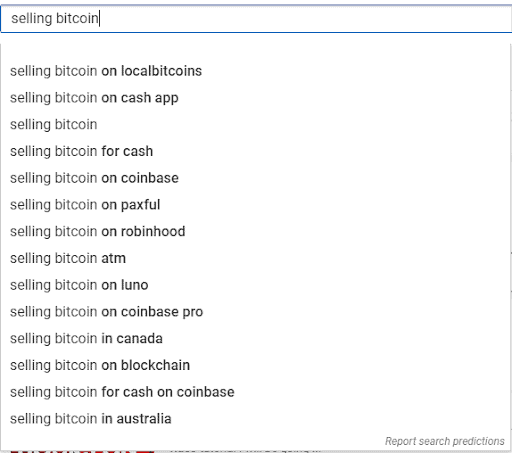
From the results shown above, it’s clear that there are several related keywords and content ideas for the chosen topic.
The best thing about these results is they are terms that people have actually searched for.
This makes them 100% relevant and valuable. The key is to find keywords with a high amount of views and low competition.
Keep reading to find out how to find out the competition of a keyword.
Click around on their videos and see what keywords they are using throughout the description and the video titles. For any keyword found, add them to an excel sheet.
Another option is to find a channel in the same niche and search for their most popular videos. This will produce a list of all of the competitor’s most viewed videos.
Take a look at their title, meta description, and video tags to see what keywords they are using to rank the videos.
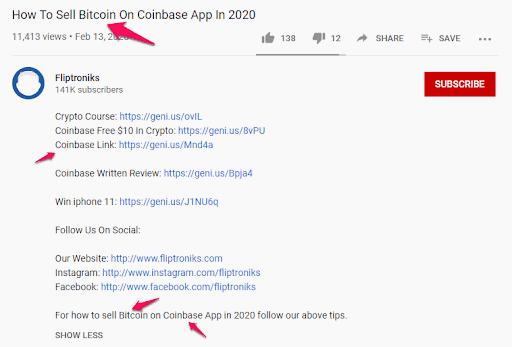
The final tactic is to use the information provided in the YouTube search report. This shows a list of all the terms people have used to find the videos on the channel.
Sometimes it can find absolute gems that can increase traffic sources.
With SEO Tools
If all the options have been exhausted from the section above, it might be time to use some SEO tools to find keywords.
Some of these tools, like Ahrefs, require a paid subscription, but the amount of keywords it generates is impressive.
Recently Ahrefs updated its keyword explorer to show search volumes for sites like YouTube. You need to enter a keyword or phrase into their keyword explorer.
The tool will then show the search volume, global search volumes, and, more importantly, a massive list of keyword suggestions.
There’s also the option to add the Google Chrome extensions TubeBuddy or VidIQ. These tools show the users “Related Queries” or “Most Used Tags.”
The tools are super easy to use and come with free or paid versions, but they can generate a massive list of keyword suggestions super quickly.
Just search a term on YouTube and use the extension to copy and paste the list on to the excel sheet.
Bonus Tip: Checking The Keyword Competition
For a new channel, it’s doubtful the videos could rank for high competition keywords. This is why it can pay to go for the smaller competition keywords.
To find the competitiveness of a keyword, use the Google search bar. Enter the keyword + site:youtube.* this will then show the number of videos on YouTube about the chosen keyword.
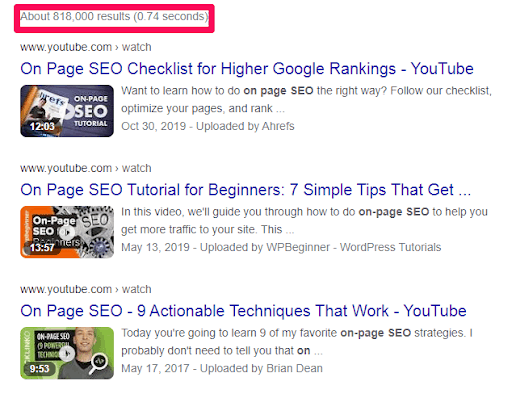
What counts as high search volume and high competitiveness, depends entirely on the niche. It’s worth doing some research to find out what qualifies as competitive and high traffic.
Video Optimization
Video optimization can be split into two main categories:
- On-Page Optimization
- In-Video Optimization
Each of the categories plays an important ranking factor for YouTube, so it’s worth paying attention to them.
Let’s take a more in-depth look:
On-Page YouTube SEO
This is all about adding value to the YouTube search engine and the user; this means thinking about four ranking factors:
Title
The title of the video should include the keyword, preferably as close to the start as possible.
Although the title should include the keyword, it still needs to be catchy, so sacrificing a part of the keyword phrase isn’t the end of the world.
The next thing to think about is keeping the title short, ideally under 60 characters seems to be the sweet spot.
It keeps the title more relevant and makes it easier for YouTube to understand it.
Tags
Tags are a great way of adding extra context to the video, and will 100% increase search rankings when used correctly.
Use the keywords that were previously found during the keyword research section. Look for the most commonly used tags for the video and add them in.
Description
The video’s description is an essential ranking factor and, when correctly optimized, can be very powerful.
Not only can it boost rankings, but it can also boost views and watch time.
The description should have the primary keywords as well as a few related terms.
Be sure to add video chapters within your description, these add an excellent opportunity for additional keywords and help viewers skip to specific parts of your video.
And 3-5 tags at the end of your description will give another boost.
Thumbnail
The thumbnail needs to complement the title of the video, which can be tricky to accomplish. Take a look at the thumbnails of videos with a high number of views.
This can give areas of inspiration. Ideally, the trick is to improve on what the competitors are doing.
The concept of YouTube thumbnail is much similar. The cover for your YouTube video is solely judged by viewers whether to click or not. The logic is simple. People will scroll if your thumbnail template is not impressive. However, you need not worry, you can create YouTube thumbnail templates more easily by using free Thumbnail Maker.
In-Video Optimization
In-video optimization is all about keeping people on the YouTube platform. The longer a channel can hold an audience, the higher it values the channel.
A good video editor will work wonders and then you should include things like:
CC/Transcriptions
This is an excellent technique for giving a video a boost in rankings. And there are a few reasons behind it.
To start with, it broadens the range of people that can view the video. YouTube videos are seen all over the world, so it pays to have translations available.
Another reason is some people believe YouTube reads the transcripts to get a better idea of what the video is about.
Add Relevant Cards
Cards are another great way of adding value to the video while keeping people on the YouTube platform.
Cards can be added at specific timestamps to suggest other videos the users might be interested in. Placing cards where most viewers tend to leave the video encourages them to remain on your channel.
Be sure only to add relevant cards and don’t stuff them; this could drop the value of the content.
End Screens
End screens don’t just keep people on the platform, but are also a great way of picking up a few extra subscriptions.
Be sure to add suggested videos at the end of the video and add a subscription for that all-important ranking boost.
Channel Optimization
Optimizing the channel page does two things; help boost the rankings and bring more subscribers to the channel.
Both of these factors can directly affect how well the video ranks.
Here’s the thing:
The more subscribers a channel has, the higher YouTube ranks your content. So create a professional-looking or fun channel page.
This can be done by adding banners, introduction videos, and writing great descriptions of the content.
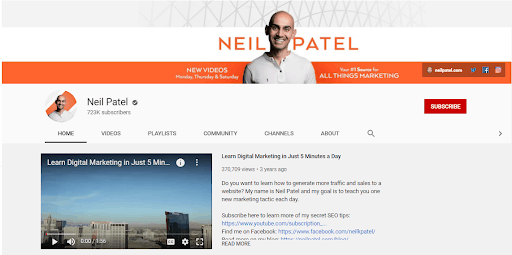
The description should include keywords that represent what the channel is about and what it needs to rank for.
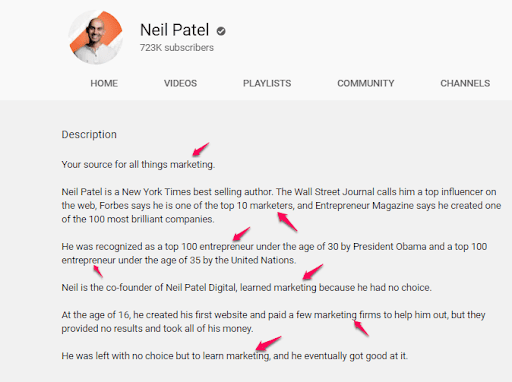
Don’t overstuff the keywords; this can be very damaging for the channel.
Rounding Up
YouTube SEO follows the same idea as more traditional SEO; it just involves a slightly different approach.
It serves as the basis for growing an audience and is the key to success. When it all boils down to it, Youtube SEO is all about three factors:
- YouTube Keyword Research
- Video Optimization
- Channel Optimization
As with any SEO project, the most important place to start is with solid keyword research. Not only will it help the videos rank, but it will also help with coming up with solid video ideas.
Remember, the trick when starting is to find keywords with high views and lower competition; this helps build a solid base of subscribers.
From there, it’s all about making sure the videos and channels are optimized to perfection; following the steps above gives any channel the chance to pave their way to success.
Don’t forget, all social media platforms can together build a larger following of subscribers. Try using Instagram to give the YouTube channel another boost.

If you found the above post useful on YouTube SEO, please share it with your followers.